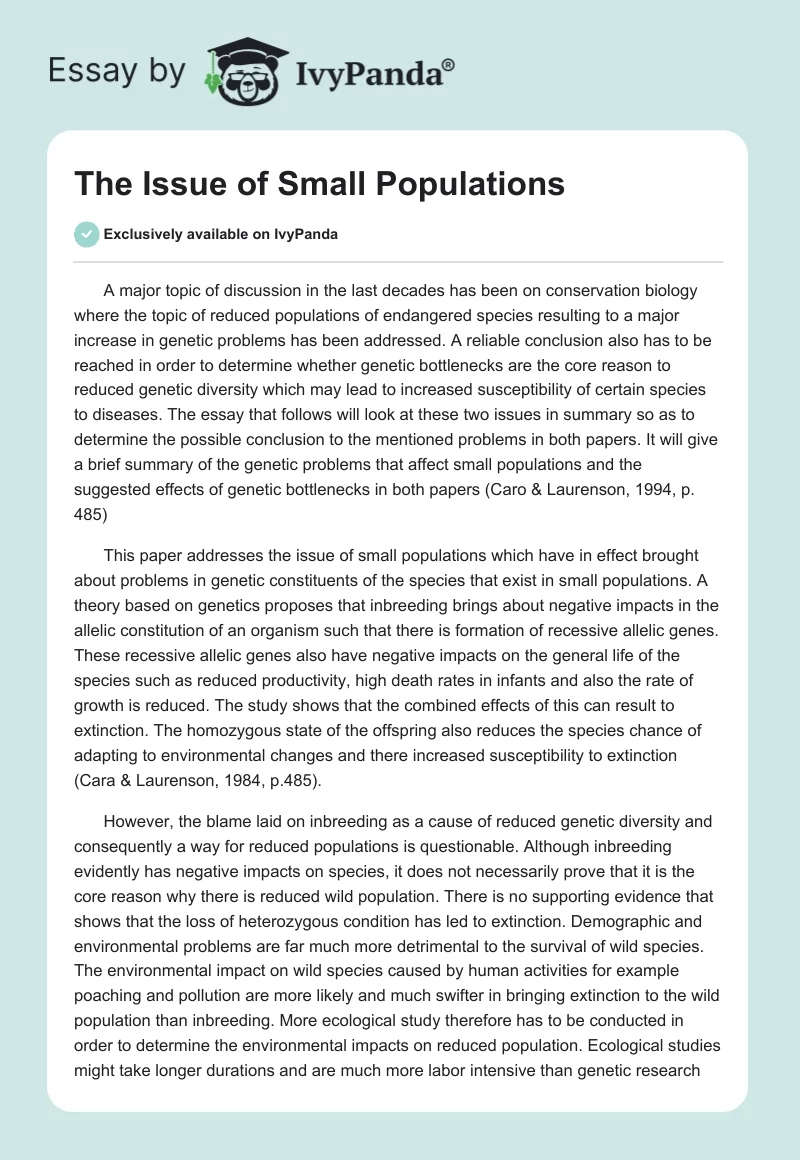A major topic of discussion in the last decades has been on conservation biology where the topic of reduced populations of endangered species resulting to a major increase in genetic problems has been addressed. A reliable conclusion also has to be reached in order to determine whether genetic bottlenecks are the core reason to reduced genetic diversity which may lead to increased susceptibility of certain species to diseases. The essay that follows will look at these two issues in summary so as to determine the possible conclusion to the mentioned problems in both papers. It will give a brief summary of the genetic problems that affect small populations and the suggested effects of genetic bottlenecks in both papers (Caro & Laurenson, 1994, p. 485)
This paper addresses the issue of small populations which have in effect brought about problems in genetic constituents of the species that exist in small populations. A theory based on genetics proposes that inbreeding brings about negative impacts in the allelic constitution of an organism such that there is formation of recessive allelic genes. These recessive allelic genes also have negative impacts on the general life of the species such as reduced productivity, high death rates in infants and also the rate of growth is reduced. The study shows that the combined effects of this can result to extinction. The homozygous state of the offspring also reduces the species chance of adapting to environmental changes and there increased susceptibility to extinction (Cara & Laurenson, 1984, p.485).
However, the blame laid on inbreeding as a cause of reduced genetic diversity and consequently a way for reduced populations is questionable. Although inbreeding evidently has negative impacts on species, it does not necessarily prove that it is the core reason why there is reduced wild population. There is no supporting evidence that shows that the loss of heterozygous condition has led to extinction. Demographic and environmental problems are far much more detrimental to the survival of wild species. The environmental impact on wild species caused by human activities for example poaching and pollution are more likely and much swifter in bringing extinction to the wild population than inbreeding. More ecological study therefore has to be conducted in order to determine the environmental impacts on reduced population. Ecological studies might take longer durations and are much more labor intensive than genetic research but they might be the key to understanding population decline and therefore help conservatives to derive ways in which the endangered species can be protected from extinction (Cara & Laurenson, 1994, p. 486)
This paper addresses the issue of genetic bottlenecks and reduced genetic diversity which has in turn made animals prone to diseases. This increased susceptibility to diseases has increased the species possibility to becoming extinct. The issue being addressed is of great importance since an understanding has to be reached so as to know the cause of reduced genetic diversity. Enough evidence is present that shows the harmful effect of inbreeding between closely related species but there is room for doubt for the fact that consistent genetic bottlenecks are the root cause of reduced genetic diversity. This can be questioned on the grounds that population is not a static item. The data that is in support of the bottleneck issue is also not reliable (O’Brien, 1989, p. 176).
The heterozygosity retainable by an individual species is purposed to be 1-12 of the population that is genetically effective. There are other risks that can lead to extinction for example demographical accidents can bring extinction to the bird population alone for over a period of 10 years. Environmental disparities also are a contributive factor to extinction and not necessarily genetic bottlenecks. Bird densities are almost static with a small variation of 0.1 to 0.5 there they are the least species that can become extinct (O’Brien, 1989, p. 177).
Variations in population densities for a given species are enough to make the population extinct for a period of a dozen generations without considering the issue of reduced genetic variability. Sluggish speed in population growth and the disparity in population density can easily bring about extinction of a rare species. There are two other possible reasons as to why decrease in genetic variability can be arrived at and not necessarily genetic bottlenecks. One of them is that animals have different mating habits one of them being polygenous which means that a few males can be responsible for mating and this will greatly reduce genetic diversity. The second reason is that a spatial structure would actually lead to a new generation with low genetic diversity (O’Brien, 1989, p.178).
Due to all this, a conclusion can be reached that the hypothesis on genetic bottlenecks is inadequate to explain the decrease in genetic variability. This hypothesis is supported by feasible explanations. Since the review is a debate between two writers a reliable conclusion has not been reached as to what might be the reason for reduced genetic variability which exposes animals to diseases and ultimately lead to extinction. Because of this, more research has to be conducted on both studies to make the reviews reliable.
Reference List
Caro, M and Laurenson, K. (1994).Ecological and Genetic Factors in Conservation: A Cautionary Tale. Science, New Series, 263 (5146), 485-486
O’Brien, S. (1989) Plausible Alternatives to Bottlenecks to Explain Reduced Genetic Diversity. Tree, 4 (6), 176-178


